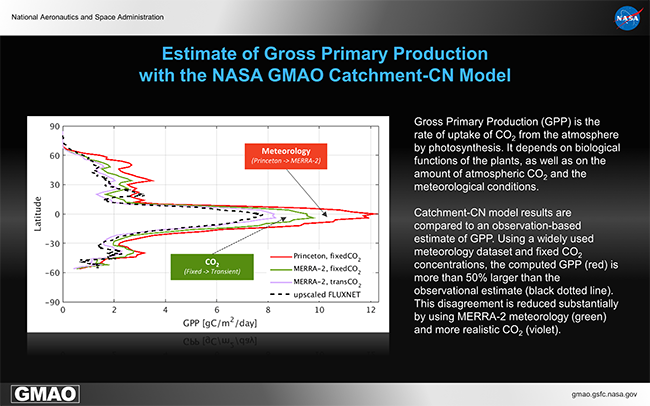Estimate of carbon fluxes generated with the NASA GMAO Catchment-CN model
Our ability to predict future variations in the carbon cycle relies heavily upon the ability of our models to accurately reproduce the current status and trends of the cycle. Understanding the carbon exchange between the atmosphere and the biosphere under a changing climate requires the skill in simulating terrestrial ecosystem processes and thereby in predicting land-atmosphere carbon fluxes. These fluxes include gross primary production (GPP), which is the amount of carbon flux from terrestrial photosynthetic activity, and net ecosystem exchange (NEE), which is the net amount of carbon flux trade between the land and the atmosphere. This work highlights new results obtained with a land-surface model that is run in an environment constrained by analyzed meteorological fields.
The NASA GMAO Catchment-CN model (Koster et al., 2014), a large-scale land surface model with dynamic phenology, currently produces carbon fluxes that are reasonably consistent with the observation-based datasets. Recent improvements in the Catchment-CN fluxes stem from applying: (1) the meteorological forcing based on the GMAO’s MERRA-2 dataset, and (2) a more realistic atmospheric CO2 condition globally to prepare the land ecosystem model, letting the CO2 concentration increase from 280ppm during the pre-industrial period to 390ppm for present-day. Use of the MERRA-2-based meteorology lowered the overestimated GPP using the Princeton meteorology (Sheffield et al., 2006) throughout the globe, with changes in the tropics as high as 2 gC/m2/day, compared to the bottom-up that fused the carbon fluxes measurements at towers using an empirical model (Jung et al., 2011). Application of the transient elevation of the atmospheric CO2 concentration profile also helped to reduce the overestimated tropical GPP, the net result being a more realistic GPP.
Similar improvements are also seen in the model estimates of the global NEE (not shown). The average global carbon sink, determined in our latest simulations, is predicted to be about 1 PgC/year, which is comparable to the estimate obtained with the well-established CASA-GFED model. The Catchment-CN estimate is close to the amount of carbon sink inferred from a residual calculation after considering the amount of carbon removed by the ocean and the atmosphere, as well as those obtained from the atmospheric inversion approach, which is top-down analysis based on the atmospheric CO2 measurements and transport modeling.
Given that the variability of terrestrial carbon cycle dynamics is still quite uncertain, the improved skill of the Catchment-CN model’s GPP estimates should contribute to NASA’s efforts to unveil the so-called “missing carbon sink” and to advance the skill of predicting future climate and ecosystem change.
References
Jung, M. et al. (2011). Global patterns of land-atmosphere fluxes of carbon dioxide, latent heat, and sensible heat derived from eddy covariance, satellite, and meteorological observations, Journal of Geophysical Research, 116, doi:10.1029/2010JG001566.
Koster, R. D., G. K. Walker, G. J. Collatz, and P. E. Thornton (2014), Hydroclimatic Controls on the Means and Variability of Vegetation Phenology and Carbon Uptake, Journal of Climate, 27(14), 5632–5652, doi:10.1175/JCLI-D-13-00477.1.
Sheffield, J., G. Goteti, and E. F. Wood (2006), Development of a 50-Year High-Resolution Global Dataset of Meteorological Forcings for Land Surface Modeling, Journal of Climate, 19(13), 3088–3111, doi:10.1175/JCLI3790.1.


